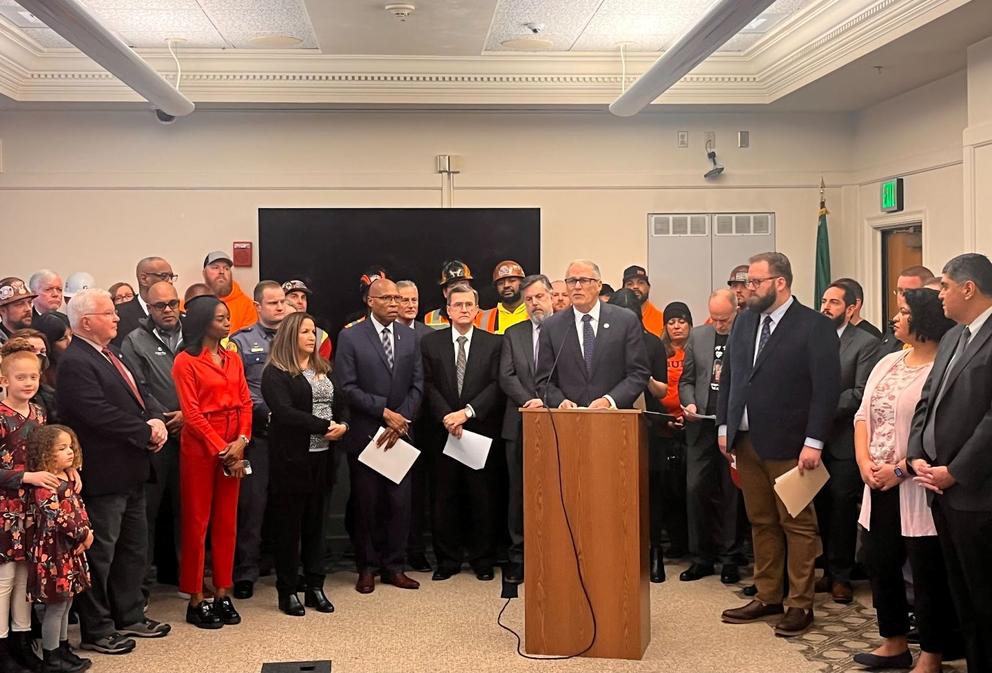While the final report on the driver who killed Michael has yet to be released from the Washington State Patrol, and it is currently unknown whether or not they were driving under the influence, Michael’s death has led his parents, Amber and David Weilert, to dedicate themselves to advocating for traffic safety more broadly.
“I couldn't imagine another mom feeling this kind of loss,” Amber said in an interview, tearing up as her husband, David, patted her hand comfortingly. “I couldn't just sit and let it happen to somebody else … I feel like it keeps Michael alive and it gives a purpose to all this pain.”
Late last month, they spoke at a press conference alongside Gov. Inslee and multiple legislators working to advance a host of bills focused on traffic safety.
The proposals include Senate Bill 5514, a bill that aims to outlaw right turns on a red light; Senate Bill 5583, which would extend the age from 18 to 25 for required driving instruction; Senate Bill 5383, which concerns pedestrian safety on crossways and roadways; and Senate Bill 5002, which would lower the blood alcohol content (BAC) for a DUI charge from 0.08% to 0.05%.
SB 5002 got off to a quick start, getting a public hearing and a bipartisan vote out of the Senate Law & Justice Committee at the start of the session. It then got its public hearing in the Senate Transportation Committee, and awaits a vote there before it could go to a vote of the full Senate.
The bill is a unique concept in the United States – only Utah has made blood alcohol levels above 0.05% illegal. Beyond the borders of the U.S., however, it’s more common, with more than 100 countries banning levels higher than 0.05%.
In the U.S. currently, commercial or professional drivers cannot legally exceed a BAC of 0.04%.
Washington experienced 745 highway fatalities in 2022, with alcohol or drug impairment playing a role in more than half, according to the Washington Traffic Safety Commission.
“In order to change the 745, we really need to change our culture, and 0.05% sends a message to everyone that we need to separate our drinking and driving,” said Shelly Baldwin, director of the traffic commission, who testified in support of the bill in the Transportation Committee hearing on Jan. 30.
According to a study by the U.S. Department of Transportation, virtually all drivers experience some form of impairment at a BAC of 0.05%, with the risk of being killed in a single-vehicle crash increasing seven to 21 times with levels of 0.05% to 0.079% as compared to 0.00%.
Most people will begin to show signs of impairment between 0.04% and 0.06%, while the most tolerant drinker begins to be impaired at a BAC of 0.08%, according to Amy Freedheim, Senior Deputy Prosecuting Attorney at King County. In Washington, you can still be charged with a misdemeanor for negligent driving in the first degree when you’re under a BAC of 0.08% if you are driving in a way that endangers or is likely to endanger any person or property.
Representatives of the alcohol and hospitality industries have expressed concerns that SB 5002 would hurt Washington’s ability to compete in the global alcohol market. On-site wine tasting, for example, may take a hit.
“I can only look at science, and science currently guides 49 of our 50 states,” Josh McDonald, executive director of the Washington Wine Institute, said in an interview. “And that science says that the current threshold that is allowed is a .08%.”
Nations such as Australia, France, Austria, Germany, Italy and Spain all have blood alcohol limits of 0.05%, while Japan, Russia, Norway and Sweden are among the nations with legal blood alcohol limits of 0.02%.
Utah, the only state in the U.S. that has lowered its legal blood alcohol limits from 0.08% to 0.05%, experienced a nearly 20% drop in traffic fatalities from 2016, before House Bill 155 was passed in 2017, to 2019, according to the National Highway Traffic Safety Administration.
“This bill has been of great benefit to the people of Utah, and tourism, hospitality and the restaurant industries have not been affected,” Rep. Thurston, R-Provo, the primary sponsor for the Utah bill, said in an interview. “I don’t understand why other states aren’t working to lower the legal limit as well.”
Legislators on both sides of the aisle are calling for more police to enforce higher traffic safety standards, echoing Gov. Inslee’s calls for increased police presence.
Sen. John Lovick, a former state trooper and SB 5002’s primary sponsor, believes people should not only be safe, they should feel safe.
“Drink all you want. We have the advantages of Uber, we have taxis, we have all those opportunities. Drink all you want, just don't drive,” Lovick, D-Mill Creek, said in an interview. “That's the message we're gonna push as hard as we can.”
If passed, SB 5002 would go into effect on Dec. 31, 2023.
The traffic safety of workers on Washington roads is also of imminent concern, with many construction workers appearing alongside Gov. Inslee at the Jan. 26 traffic safety press conference.
“We owe these people safety when they’re taking care of our safety,” Gov. Inslee said. “They’re trying to get us home safe from work and school, we want to get them home safe from work.”
Sen. Marko Liias, D-Edmonds, has proposed Senate Bill 5272, which if passed would authorize the use of speed safety camera systems in state highway work zones until 2030.
Several of the bills included in this traffic safety package have gotten public hearings as the annual legislative session unfolds. From here, lawmakers will have to approve the bills in their committees, then get them to the House and Senate floor, for a chance to make it to Inslee’s desk for his signature.





